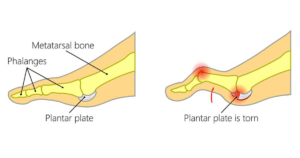Plantar Plate Tear
What is the Plantar Plate?
The plantar plate is a thick ligament located in the ball of the foot, connecting to the joints of the toes. Its primary role is to:
Protect the head of the metatarsal bones from excessive pressure
Prevent the toes from spreading too far apart
Limit overextension of the toes
When this ligament is overloaded or strained, it can develop a tear, leading to discomfort and functional issues.

How Does a Plantar Plate Tear Occur?
A plantar plate tear commonly affects the second toe, as it is often the longest. Several factors contribute to this condition, including:
✔ Over-pronation (rolling the feet inward excessively)
✔ Presence of a bunion or hammer toe
✔ Having a long second metatarsal bone
✔ High-impact activities such as running, dancing, or climbing stairs
Symptoms of a Plantar Plate Tear
Individuals with a plantar plate tear often experience:
Persistent pain and swelling under the ball of the foot, extending toward the toes
Increased pain when bending the toe upwards
Visible swelling and redness on the top of the foot
A sensation of ‘walking on bones’
A distinct ‘V’ sign where the affected toes appear more separated than usual
Diagnosing a Plantar Plate Tear
Diagnosing a plantar plate tear can be complex due to the intricate structure of the foot. A podiatrist may perform:
A physical examination to assess pain and mobility
Imaging studies, such as ultrasound or MRI, to confirm the extent of the tear
Treatment for a Plantar Plate Tear
Non-Surgical Treatment Options
Initial treatment aims to relieve pain and prevent further damage. This may include: ✔ Strapping & taping to support the toe and reduce strain ✔ Padding & offloading to protect the injured area ✔ Footwear modifications to ensure proper support ✔ Activity modification to avoid aggravating movements ✔ Anti-inflammatory medications to reduce swelling
Once the pain subsides, the focus shifts to addressing underlying contributing factors such as bunions, hammer toes, and overpronation. Your podiatrist may recommend:
Custom orthotics to offload pressure from the affected area
Strengthening exercises to enhance foot stability and alignment
Surgery for a Plantar Plate Tear
In severe or chronic cases, surgical intervention may be necessary. Surgical options include:
Plantar plate repair to restore the ligament
Resection osteotomy to correct bone alignment
Recovery & Expected Outcomes
The recovery period varies depending on the severity of the tear. Most patients experience significant pain relief within 3-4 months, with early symptom improvement allowing many to resume normal activities within one month.
Plantar Plate Tear FAQs
Do bunions cause a plantar plate tear?
Yes, bunions can contribute to a plantar plate tear by increasing pressure on the ligament, leading to thinning and stretching.
How do you tear your plantar plate?
A plantar plate tear results from excessive strain due to over-pronation, bunions, hammer toes, and high-impact activities.
How long does a plantar plate tear take to heal?
Most patients recover within 3-4 months, though healing time varies depending on severity and treatment adherence.
Is it okay to walk on a plantar plate tear?
Walking on a plantar plate tear should be done with caution. Avoid walking barefoot and wear supportive shoes or prescribed orthotics to prevent further damage.
Get Expert Care for a Plantar Plate Tear
If you’re experiencing pain in the ball of your foot, our podiatrists are here to help. Book an appointment today!
